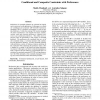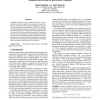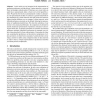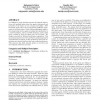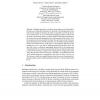FLAIRS
2008
14 years 5 months ago
2008
Preferences in constraint problems are common but significant in many real world applications. In this paper, we extend our conditional and composite CSP (CCCSP) framework, managi...
AAAI
2008
14 years 5 months ago
2008
Changing preferences is very common in real life. The expressive power of the operations of preference change introduced so far in the literature is limited to adding new informat...
AAAI
2007
14 years 5 months ago
2007
In many interactive decision making scenarios there is often no solution that satisfies all of the user’s preferences. The decision process can be helped by providing explanati...
ENTER
2006
Springer
14 years 6 months ago
2006
Springer
Knowing tourists' individual preferences provides the possibility to offer personalised tours. The challenge is to capture these preferences using a mobile device. During a f...
ECAI
2006
Springer
14 years 6 months ago
2006
Springer
In this article we are interested in the representation of qualitative preferences with the help of 3-points intervals (a vector of three increasingly ordered points). Preferences ...
ATAL
2006
Springer
14 years 6 months ago
2006
Springer
It is difficult to reach optimal outcomes in bilateral negotiations with multiple issues when the agents' preferences and priorities of the issues are not common knowledge. S...
VLDB
1994
ACM
14 years 7 months ago
1994
ACM
This paper introduces a formalism to describe the needs and preferences of database users. Because of the precise formulation of these concepts, we have found an automatic and ver...
ECAI
2000
Springer
14 years 7 months ago
2000
Springer
Abstract. Scheduling meetings is generally difficult in that it attempts to satisfy the preferences of all participants. However, all participants can agree to a schedule in which...
ECSQARU
2001
Springer
14 years 7 months ago
2001
Springer
Abstract. Intelligent agents have to be able to merge inputs received from different sources in a coherent and rational way. Recently, several proposals have been made for the merg...
IPMU
2010
Springer
14 years 8 months ago
2010
Springer
Abstract. Dialogue moves influence and are influenced by the agents’ preferences. We propose a method for modelling this interaction. We motivate and describe a recursive metho...
